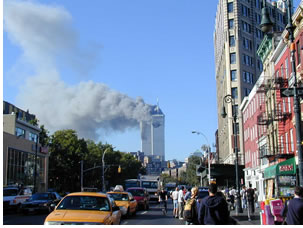
—September 12—Washington, D.C.
The shocking news of the World Trade Center disaster Tuesday morning, September 11, was followed only minutes later by the equally distressing sight of thick black smoke billowing just across the Potomac to the north, from the Pentagon.
Rumors flew but panic was nowhere to be found as AIA EVP/Chief Executive Officer Norman L. Koonce, FAIA, assembled the AIA national component staff in the AIA headquarters Boardroom to begin an evacuation of the building, which sits a block west of the White House grounds. The streets were filled with barely moving cars interspersed with shrill-sirened Secret Service convoys. The sidewalks were awash with eerily calm pedestrians taking, as it turned out, the quickest mode of transportation out of the area. Some braved the subway, some went to friends' houses, but nearly everybody left the area immediately so the authorities could do their job. Within hours the streets looked as if it were early Sunday morning.
 Everyone
grieved and came to terms with the day's horrors in his or her own way.
By Wednesday morning, though, the AIA national component was back to work.
Koonce called a second all-staff gathering to encourage people to talk
to their colleagues, share their experiences and thoughts, and unburden
their collective conscience. He pointed out the importance of the AIA
mission, even in a time when the magnanimity of the previous days' tragedy
made everyday activity seem trivial in comparison. That the terrorist
attackers chose buildings that symbolize America—its dominance in
business, trade, and military might—shows the overwhelming importance
of architectural form, which is so ingrained in the public psyche as to
be almost subconscious. "We have important work to do," Koonce
told his staff.
Everyone
grieved and came to terms with the day's horrors in his or her own way.
By Wednesday morning, though, the AIA national component was back to work.
Koonce called a second all-staff gathering to encourage people to talk
to their colleagues, share their experiences and thoughts, and unburden
their collective conscience. He pointed out the importance of the AIA
mission, even in a time when the magnanimity of the previous days' tragedy
made everyday activity seem trivial in comparison. That the terrorist
attackers chose buildings that symbolize America—its dominance in
business, trade, and military might—shows the overwhelming importance
of architectural form, which is so ingrained in the public psyche as to
be almost subconscious. "We have important work to do," Koonce
told his staff.
Communications simple and ornate came into the AIA
on Wednesday the 12th. Mike Borshevski, Assoc. AIA, emailed from Russia:
"It is awful! We with you!"
From Dorothy D. Barkley, executive director of the
Architectural Institute of British Columbia:
I am writing on behalf of AIBC President Michael Burton-Brown, MAIBC,
Council, members and staff to express our condolences to you, the AIA
Board, members and staff following yesterday's tragedy. It was with profound
horror, shock and revulsion that we listened to the events unfold over
the day. All of us were touched one way or another, and can only imagine
how you felt as this devastating event happened affecting all of the United
States and its people. Our thoughts, our sympathy and our wishes for resolution
go to you. While we may not be in a position to meaningfully participate
in the recovery from this catastrophe, that which we may or are able to
do is available to you. American Architects will be called upon to play
a large role in the rebuilding of national confidence and security through
their design and planning skills, and will demonstrate to the world the
indomitable spirit of the American people.
The AIA national component returns those well wishes even as everyone's thoughts focus most intently on the victims and their families and friends.
Copyright 2001 The American Institute of Architects. All rights reserved.
![]()
|
Bruce Eisenberg, AIA, of the AIA New York Chapter took this photo at about 9 AM EDT, September 11, looking south from 6th Ave and W. 4th St in the East Village seconds after the second plane hit. He was on a site visit. For an eye-witness account of the horror in lower Manhattan, see the article by Robert Ivy, FAIA, in Architectural Record online. |
|